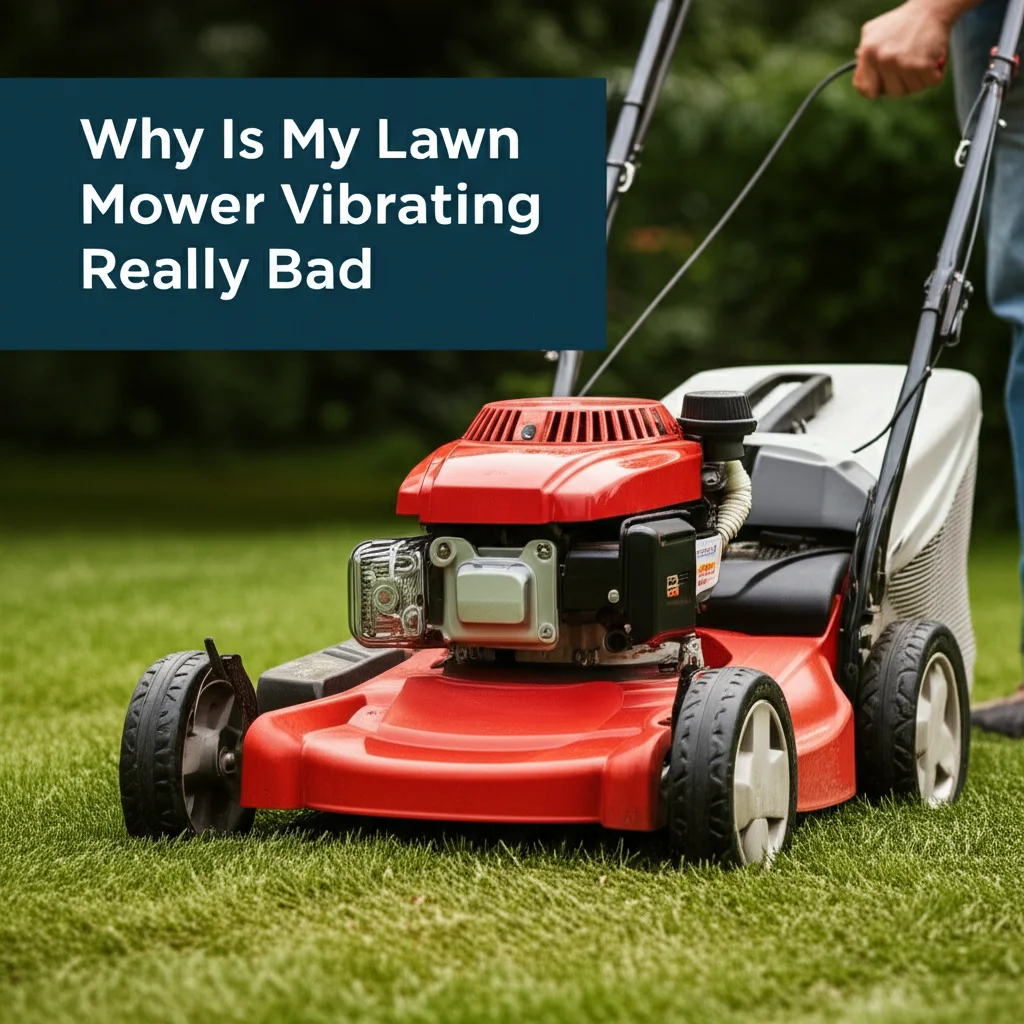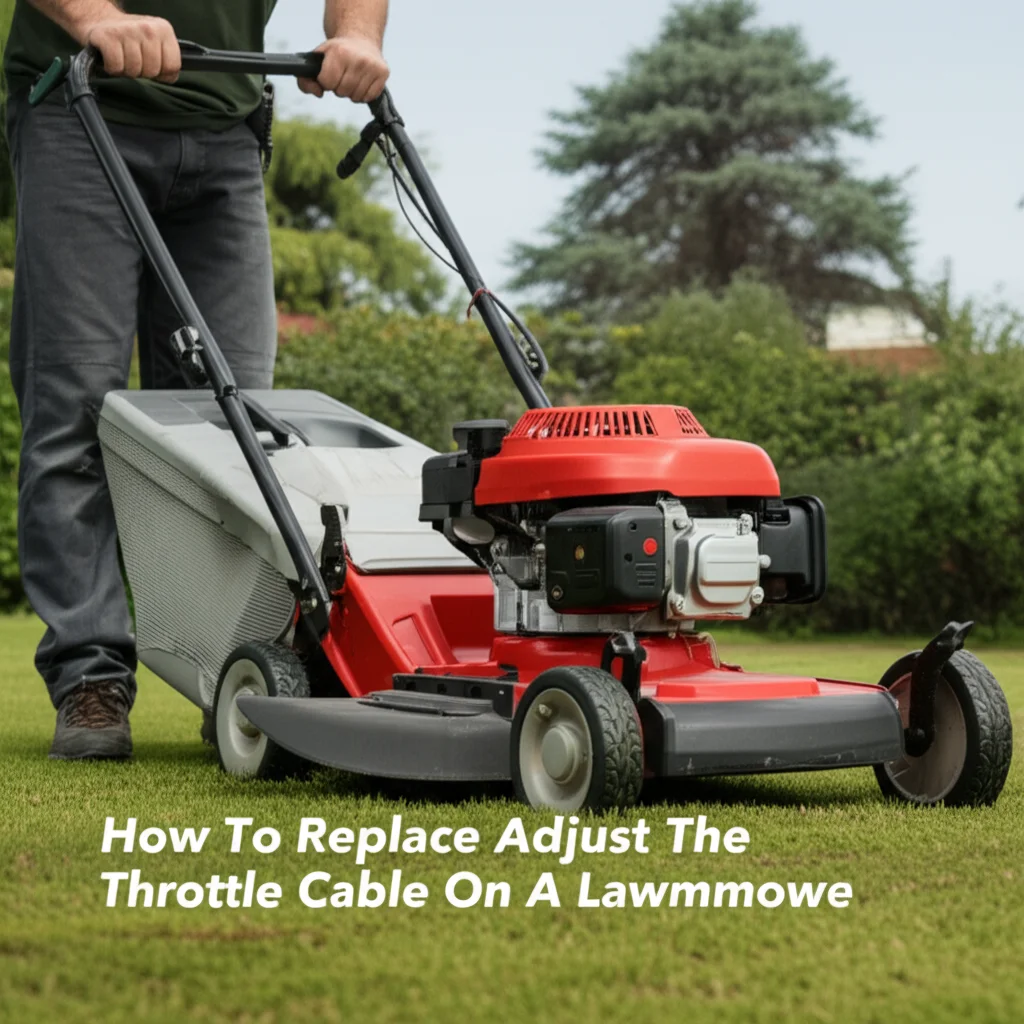· Lawn Mower Maintenance · 11 min read
Why Is My Lawn Mower Shaking

Why Is My Lawn Mower Shaking? Complete Troubleshooting Guide
Nothing disrupts a peaceful mowing session quite like a lawn mower that suddenly starts shaking violently. If you’re wondering “why is my lawn mower shaking,” you’re not alone – this common issue affects countless homeowners every mowing season.
Understanding the root causes and solutions can save you time, money, and frustration while keeping your lawn looking pristine.
Key Takeaways
• Unbalanced or damaged blades are the most common cause of lawn mower shaking
• Loose engine mounting bolts can create severe vibration throughout the entire machine
• Bent crankshafts from impact damage often require professional repair or replacement
• Debris buildup under the deck can cause imbalance and excessive vibration
• Regular maintenance prevents most shaking issues before they become serious problems
Quick Answer: Lawn mower shaking typically results from unbalanced or damaged blades, loose engine components, bent crankshafts, or debris accumulation. Most issues can be resolved through proper blade maintenance, tightening loose bolts, and regular cleaning.
Understanding Why Lawn Mowers Shake
When your lawn mower starts vibrating badly, it’s essentially telling you that something has disrupted its delicate balance. Modern lawn mowers are engineered to operate smoothly, with all rotating components working in harmony.
Any disruption to this balance – whether from damaged parts, loose connections, or foreign objects – manifests as noticeable shaking or vibration.
The intensity of the shaking often indicates the severity of the problem. Light vibration might suggest minor blade imbalance, while violent shaking could signal serious engine damage.
Understanding these warning signs helps you determine whether you’re dealing with a simple fix or a more complex repair that might require professional attention.
Most lawn mower shaking issues stem from the cutting system, engine mounting, or accumulated damage from normal wear and tear. The good news is that many of these problems are preventable through regular maintenance and careful operation.
Unbalanced or Damaged Blades: The Primary Culprit
Unbalanced lawn mower blades represent the leading cause of mower shaking, accounting for roughly 70% of all vibration issues. When blades become unbalanced – whether through normal wear, impact damage, or improper sharpening – they create centrifugal forces that translate into noticeable shaking throughout the entire machine.
Several factors contribute to blade imbalance:
Hitting solid objects like rocks, tree roots, or decorative elements can chip, bend, or crack blades. Even minor damage disrupts the blade’s weight distribution, causing vibration during operation. This explains why many homeowners notice lawn mower shaking after hitting a rock.
Uneven sharpening occurs when blades are ground incorrectly, removing more material from one side than the other. Professional sharpening services typically avoid this issue, but DIY sharpening without proper equipment often creates imbalance.
Normal wear patterns develop over time as blades cut through grass, sand, and debris. One end of the blade may wear faster than the other, gradually creating imbalance that worsens with continued use.
To check for blade balance, remove the blade and hang it on a nail through the center mounting hole. A balanced blade will hang level, while an unbalanced blade will tip toward the heavier side. If imbalance is detected, professional sharpening or blade replacement is necessary.
Loose Engine Components and Mounting Issues
Engine mounting problems create some of the most dramatic shaking issues in lawn mowers. The engine generates significant rotational and reciprocating forces during operation, and these forces must be properly contained by secure mounting systems.
Engine mounting bolts connect the engine to the mower deck through rubber isolators designed to absorb normal vibration. When these bolts loosen – often due to the constant vibration of normal operation – the engine begins moving independently of the deck, creating severe shaking that’s felt throughout the entire machine.
Worn engine mounts lose their ability to absorb vibration effectively. The rubber components deteriorate over time, becoming hard and brittle. This deterioration allows more engine vibration to transfer to the deck and handle, making normal engine operation feel much rougher than it should.
Loose blade mounting bolts create a different but equally concerning problem. When the bolt securing the blade to the crankshaft loosens, the blade begins wobbling during rotation. This wobble not only causes severe vibration but can also damage the crankshaft threads if not addressed promptly.
Regular inspection of all mounting hardware should be part of your routine maintenance schedule. Most mounting bolts should be checked and tightened according to manufacturer specifications at least once per season.
Bent Crankshaft Problems
A bent crankshaft represents one of the most serious causes of lawn mower shaking, often requiring professional repair or complete engine replacement. The crankshaft connects the engine’s internal components to the cutting blade, and any distortion in this critical component creates severe vibration throughout the entire system.
Impact damage is the primary cause of bent crankshafts. When a mower blade strikes an immovable object with sufficient force, the sudden stoppage can bend the crankshaft. This type of damage often occurs when mowing over hidden rocks, tree stumps, or other solid obstacles.
Gradual bending can occur over time if blade mounting bolts become extremely loose. The wobbling blade creates uneven forces on the crankshaft, potentially causing gradual distortion that worsens with continued operation.
Signs of a bent crankshaft include:
- Severe shaking that begins immediately when the engine starts
- Visible wobbling of the blade when viewed from above
- Difficulty starting or rough engine operation
- Metal-on-metal grinding sounds during operation
Crankshaft problems typically require professional diagnosis and repair. The cost of replacement often approaches the value of older mowers, making this a critical factor in repair-versus-replace decisions.
Debris Accumulation and Deck Issues
Grass clippings, leaves, and other organic debris naturally accumulate under mower decks during normal operation. While small amounts of buildup rarely cause problems, significant accumulation can create imbalance severe enough to cause noticeable shaking.
Wet grass clippings are particularly problematic because they stick to deck surfaces and blade assemblies. These sticky masses can build up quickly during mowing sessions, especially when cutting damp or dewy grass. The accumulated material adds weight to one side of the rotating assembly, creating imbalance.
Compacted debris forms when organic material becomes tightly packed in deck corners and around blade mounting areas. This compacted material is difficult to remove with normal cleaning methods and often requires scraping or pressure washing to eliminate completely.
Foreign objects occasionally become lodged in deck areas, creating sudden and severe imbalance. Wire, rope, plastic bags, and similar materials can wrap around blade assemblies or become wedged in deck spaces, causing immediate and dramatic shaking.
Prevention involves regular deck cleaning after each mowing session, particularly when cutting wet or overgrown grass. Most manufacturers recommend cleaning the underside of the deck weekly during peak growing season.
Engine-Related Vibration Causes
While blade and mounting issues cause most lawn mower shaking, internal engine problems can also contribute to excessive vibration. These issues are often more subtle initially but tend to worsen over time if not addressed.
Worn engine bearings allow increased movement of internal rotating components. As bearings wear, the engine’s internal balance deteriorates, creating vibration that increases with engine speed. This type of vibration is often accompanied by unusual engine noises or changes in performance.
Carbon buildup on internal engine components can create imbalance in the combustion process. Uneven carbon deposits on pistons, valves, or combustion chambers cause irregular engine operation that manifests as vibration or rough running.
Loose internal components such as connecting rods or crankshaft counterweights can create severe internal imbalance. These problems typically develop gradually but can cause dramatic vibration once they reach critical levels.
Engine-related vibration issues often require professional diagnosis and repair. However, regular maintenance including oil changes, air filter replacement, and fuel system cleaning can prevent many of these problems from developing.
For additional troubleshooting help with engine issues, you might find our guide on Briggs and Stratton lawn mower running rough helpful for addressing performance-related concerns.
Step-by-Step Troubleshooting Guide
Systematic troubleshooting helps identify the specific cause of lawn mower shaking quickly and safely. Always ensure the engine is off and cool before beginning any inspection or repair work.
Safety First: Disconnect the spark plug wire and engage the parking brake before beginning any inspection. This prevents accidental starting during troubleshooting procedures.
Visual Inspection Steps:
- Check for obvious damage to blades, deck, or engine components
- Look for loose or missing bolts in mounting areas
- Inspect the blade for chips, cracks, or significant wear
- Examine the deck for debris accumulation or foreign objects
- Check engine mounting points for looseness or damage
Operational Testing: Start with the blade disengaged to determine if shaking occurs with engine operation alone. If the engine runs smoothly without the blade engaged, the problem likely involves the cutting system. If shaking persists with the blade disengaged, engine or mounting issues are more likely.
Progressive Diagnosis: Begin with the simplest potential causes and work toward more complex issues. Clean debris, tighten loose bolts, and check blade balance before investigating internal engine problems or crankshaft damage.
Many homeowners find that systematic troubleshooting reveals multiple minor issues that combine to create severe shaking. Addressing all identified problems simultaneously often provides better results than fixing issues individually.
Professional Repair vs. DIY Solutions
Determining when to attempt repairs yourself versus seeking professional help depends on your mechanical skills, available tools, and the specific nature of the problem. Some issues are well within the capabilities of most homeowners, while others require specialized equipment and expertise.
DIY-Friendly Repairs:
- Cleaning debris from deck areas
- Tightening loose mounting bolts
- Balancing or replacing lawn mower blades
- Replacing worn engine mounts
- Basic maintenance tasks
Professional Repairs Recommended:
- Bent crankshaft diagnosis and repair
- Internal engine component replacement
- Complex electrical or fuel system issues
- Warranty-covered repairs
- Safety-critical component replacement
Cost Considerations: Professional diagnosis typically costs $50-100, while major repairs can range from $150-400 depending on the specific problem. For older mowers, repair costs approaching 50% of replacement value often make new equipment a more economical choice.
If you’re experiencing starting issues along with shaking, our troubleshooting guide for why won’t my lawn mower start after winter provides additional diagnostic steps that might help identify related problems.
Prevention and Maintenance Tips
Preventing lawn mower shaking is far easier and less expensive than repairing damage after it occurs. Regular maintenance and careful operation practices eliminate most causes of excessive vibration.
Regular Blade Maintenance:
- Inspect blades monthly during mowing season
- Sharpen blades at least twice per year
- Replace blades showing significant wear or damage
- Always balance blades after sharpening
Engine Care Practices:
- Check and tighten mounting bolts monthly
- Change engine oil according to manufacturer recommendations
- Replace air filters regularly to maintain proper engine operation
- Store mowers properly during off-season periods
Operational Best Practices:
- Walk mowing areas before cutting to identify potential hazards
- Avoid mowing wet grass when possible
- Clean deck areas after each use
- Operate mowers at recommended speeds
Seasonal Maintenance Schedule: Spring preparation should include thorough inspection of all components, blade sharpening, and engine tune-up. Mid-season maintenance involves regular cleaning and bolt tightening. Fall preparation includes proper storage procedures and winter-specific maintenance tasks.
For mowers experiencing multiple issues, comprehensive maintenance often addresses shaking problems while improving overall performance and longevity.
Frequently Asked Questions
How do I know if my lawn mower blade is unbalanced? Remove the blade and hang it on a nail through the center mounting hole. A balanced blade hangs level, while an unbalanced blade tips toward the heavier side. You can also check for visible chips, cracks, or uneven wear patterns that indicate balance problems.
Why does my lawn mower shake when I engage the blades? Shaking that begins when blades engage typically indicates blade-related problems such as damage, imbalance, or loose mounting. Less commonly, it can signal crankshaft issues or debris accumulation around the cutting assembly.
Can I continue using a shaking lawn mower? Operating a severely shaking mower can cause additional damage to engine components, deck structures, and blade assemblies. Minor vibration may be acceptable temporarily, but significant shaking should be addressed before continued use.
How much does it cost to fix a vibrating lawn mower? Simple fixes like blade replacement or bolt tightening cost $20-50. Professional diagnosis runs $50-100, while major repairs like crankshaft replacement can cost $200-400. Many issues can be resolved with basic maintenance and DIY repairs.
What causes a lawn mower to shake violently? Violent shaking usually indicates severe blade damage, bent crankshafts, or completely loose mounting components. This level of vibration requires immediate attention to prevent further damage and ensure safe operation.
How often should I check my lawn mower for vibration issues? Monthly inspections during mowing season help identify developing problems before they become severe. Check blade condition, mounting bolt tightness, and overall operation regularly as part of routine maintenance.
Why does my lawn mower vibrate more on uneven terrain? Uneven surfaces can amplify existing vibration issues and make minor problems more noticeable. However, significant vibration on any terrain typically indicates mechanical problems that require attention regardless of mowing conditions.
Final Words
Understanding why your lawn mower is shaking empowers you to address problems quickly and effectively, whether through simple maintenance or professional repair. Most shaking issues stem from preventable causes like unbalanced blades, loose components, or debris accumulation – problems that regular maintenance easily prevents.
The key to resolving lawn mower vibration lies in systematic diagnosis, starting with the most common causes and working toward more complex issues. While some repairs require professional expertise, many homeowners can successfully address basic shaking problems with proper tools and careful attention to safety procedures.
Don’t let a shaking lawn mower disrupt your lawn care routine or potentially cause more expensive damage through continued operation. Take action at the first signs of excessive vibration, and you’ll keep your mower running smoothly for years to come.
For additional lawn mower troubleshooting resources and maintenance tips, explore our comprehensive guides covering everything from starting problems to performance issues.



